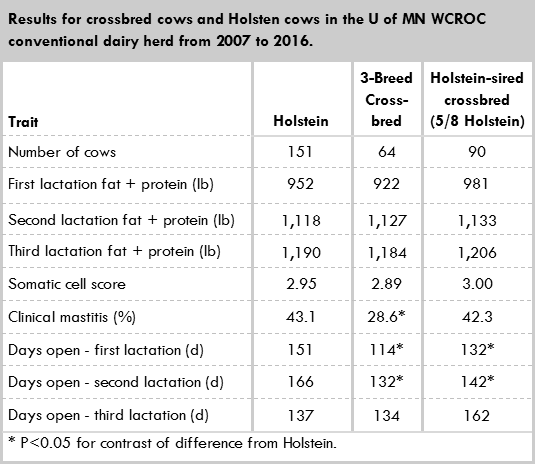By Brad Heins, Associate Professor of Dairy Science
November 2017
Crossbreeding of dairy cattle is a topic of growing interest around the world because of dairy producer concerns regarding calf survival, cow fertility, and cow health of Holstein cattle. Over the past decade, Jersey was often the first breed of choice for crossbreeding with the Holstein breed in the United States because the Jersey breed has the second largest number of cows among the pure breeds in the United States. Recent crossbreeding research has focused on the performance and profitability of Jersey, Brown Swiss, Normande, Montbéliarde, and Viking Red sires mated to Holstein cattle However, dairy producers must decide how to mate the 2-breed crossbred, and some have chosen to backcross to one of the parent breeds. Others have chosen to implement a 3-breed rotational crossbreeding system. The use of 3 breeds maintains higher average levels of heterosis across generations than a 2-breed crossbreeding system. Few studies have evaluated performance of the 3-breed and third generation Holstein-sired crossbred cows under various management systems.& We wanted to determine differences between 3-breed crossbreds, third generation Holstein-sired crossbreds (5/8 Holstein), and pure Holstein cows for fertility, production, and SCS during their first three lactations in a seasonal-pasture production system.

The West Central Research and Outreach Center, Morris, Minnesota, has a low-input, seasonal grazing facility that houses 250 cows. Cows are fed a TMR diet during the entire year; however, cows consume 30% of their diet from pasture during May to October. Crossbreeding began in December 2000 with the mating of 50% of Holstein cows and heifers to Jersey AI sires and the other 50% to Holstein AI sires. All of the resulting Jersey×Holstein crossbreds were mated to Montbéliarde bulls to initiate a 3-breed rotational system for crossbreeding. Subsequently, in 2002, some multiparous Holstein cows were mated to Montbéliarde bulls to provide comparison of Holstein and Montbéliarde×Holstein crossbreds. Initially, the Montbéliarde×Holstein were mated to Jersey bulls; however, recently the Montbéliarde×Holstein cows were mated to Viking Red bulls, based on shortcomings of the Jersey breed in a confinement rotational crossbreeding system. Therefore, into the future, University of Minnesota crossbreds will be rotational crossbreds of Holstein, Viking Red, and Montbéliarde.
Three-breed crossbred cows (Montbéliarde×Jersey×Holstein and Jersey×Montbéliarde×Holstein; n = 64) and Holstein-sired crossbred cows (Holstein×Montbéliarde×Jersey×Holstein and Holstein×Jersey×Montbéliarde×Holstein; n = 90) were compared to Holstein cows (n = 151) for 305-day fat plus protein production and SCS during their first three lactations. The accompanying table has results for fat plus protein production. The 3-breed crossbred cows and Holstein-sired crossbred cows had similar fat plus protein production compared to Holstein cows during all three lactations. During first lactation, the 3-breed crossbred cows had higher SCS than Holstein cows (3.22 vs. 2.80, respectively). The 3-breed crossbred cows may have had higher SCS during first lactation because of the higher percentage of Jersey genetics in the 3-breed crossbred cows.& Jersey cattle have a higher breed average for SCS than Holstein cattle in the United States, which likely contributed to the increase in SCS of the 3-breed crossbred cows in first lactation.
During first lactation, Holstein cows had mean days open of 151 days, and the 3-breed crossbred cows (114 d) and Holstein-sired crossbreds (132 d) had fewer days open than Holstein cows. During second lactation, the days open for the Holstein cows increased dramatically to 166 days, and the 3-breed crossbred and Holstein-sired crossbreds had a three to four-week advantage for days open compared to the Holstein cows.
Reproductive performance has been overlooked by many when comparing purebreds and crossbreds. For this study, crossbred cows had fewer days open and similar fat plus protein production compared with pure HO cows, and these advantages for crossbreds should have substantial impact on profitability of dairying. In this seasonal-pasture herd, Holstein-sired crossbred offspring from a 3-breed crossbred dam had similar production and superior fertility compared to pure HO cows. Therefore, mating 3-breed crossbreds to Holstein bulls may have advantages in a rotational crossbreeding system. Three distinct breeds are likely optimum for a rotational crossbreeding system.
